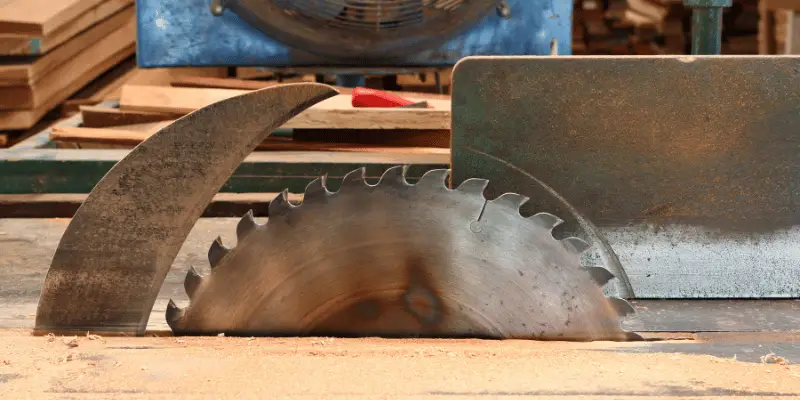Mitre saws are ideal for making precise angled cuts, while table saws excel at rip and crosscuts. Both tools have unique features and applications, making them essential for any woodworking shop.
Mitre saws are a popular choice for cutting precise angles on wood, making them a favorite among carpenters and home DIY enthusiasts. Table saws, on the other hand, are versatile tools that excel in making straight cuts, including ripping and crosscutting large boards.
Understanding the differences between these two powerful tools can help you choose the right one for your woodworking projects. We’ll explore the unique features and applications of mitre saws and table saws, helping you make an informed decision for your woodworking needs.
Understanding Mitre Saw And Table Saw
The right selection of power tools is crucial for any woodworking or construction project. Among the various options available, understanding the differences and functionalities of the mitre saw and table saw can help you make an informed decision. Both tools have their unique features and applications, making them suitable for different tasks.
Functionality And Basic Differences
When it comes to functionality, the mitre saw is designed for making precise angled cuts, making it ideal for tasks such as crown molding, picture frames, and door frames. On the other hand, a table saw is primarily used for making straight cuts on larger pieces of wood or other materials.
Pros And Cons Of Mitre Saw
- Excellent for making angled cuts with precision
- Compact and portable, suitable for smaller workspaces
- Can be used for bevel cuts as well
- Limited to smaller cuts compared to a table saw
- Not suitable for ripping long pieces of wood
- Less versatile than a table saw
Pros And Cons Of Table Saw
- Capable of making straight, long cuts on larger materials
- Versatile, can be used for various woodworking tasks
- Efficient for ripping and cross-cutting wide boards
- Requires more space due to its larger size
- Less portable compared to a mitre saw
- May be less precise for angled cuts compared to a mitre saw
Factors Affecting Precision Cuts
Factors Affecting Precision Cuts are crucial in determining the effectiveness of precision tools such as Mitre Saws and Table Saws. To achieve the high-level precision required for woodworking or carpentry projects, several factors come into play. Blade types and angles, workpiece stability and support, and accuracy of cutting guides all significantly impact the precision of cuts.
Blade Types And Angles
The type and angle of the blade are fundamental to achieving precise cuts. Each type of saw has specific blade designs tailored for different cutting tasks. Mitre Saws generally feature a circular blade with fine teeth, ideal for cross-cutting and mitering. On the other hand, Table Saws usually come with larger blades designed for rip cuts and wider cross-cuts. Additionally, understanding the blade’s tilt and bevel angles is crucial in achieving precise angles and miters in woodworking projects.
Workpiece Stability And Support
Stability and support of the workpiece play a critical role in achieving precise cuts. Both Mitre Saws and Table Saws require the workpiece to be secured firmly to prevent any movement during cutting. Clamps, sacrificial fences, and adjustable supports are essential components to ensure the workpiece remains stable throughout the cutting process. Proper workpiece support can minimize vibration and ensure accurate cutting.
Accuracy Of Cutting Guides
The accuracy of cutting guides also significantly influences precision cuts. Mitre Saws and Table Saws rely on cutting guides to maintain straight and precise cuts. Ensuring that the cutting guides are aligned correctly with the blade path is crucial to achieving precise cuts. Additionally, ensuring that the guides are well maintained and free from any debris or damage is essential to ensure consistent accuracy in cuts.

Precision Cutting Applications
When it comes to precision cutting applications, both mitre saws and table saws are essential tools for various projects. Let’s compare their effectiveness and suitability for different cutting tasks.
Fine Woodworking Projects
For fine woodworking projects that require intricate and precise cuts, a mitre saw is the preferred tool. Its ability to make angled cuts with accuracy makes it indispensable for creating detailed and flawless woodwork.
Carpentry And Construction Projects
When it comes to carpentry and construction projects that demand straight and consistent cuts, a table saw takes the lead. Its stable and large work surface allows for precise and repetitive cuts, making it the go-to tool for large-scale construction tasks.
Diy Home Improvement Projects
For DIY home improvement projects that involve a mix of straight cuts and angles, both the mitre saw and table saw come into play. However, a mitre saw excels in creating precise angled cuts for molding and trim work, while a table saw is ideal for cutting large sheets of material with accuracy.
Frequently Asked Questions For Mitre Saw Vs Table Saw
Which Is Better For Cross-cutting, A Mitre Saw Or A Table Saw?
A mitre saw is more suitable for cross-cutting, providing accurate angles and smooth cuts. Table saws can also cross-cut, but may require additional tools for precision.
Can Dado Cuts Be Made With A Mitre Saw Or A Table Saw?
Dado cuts are best made with a table saw, which is equipped to handle wider and deeper cuts. While possible with a dado blade on a mitre saw, the table saw provides more stability and control.
Is A Mitre Saw Or A Table Saw Better For Ripping Lumber?
A table saw is the ideal choice for ripping lumber, as it offers a wider cutting capacity and adjustable fence for precise cuts. While possible on a mitre saw, its primary function is angled and cross cuts.
Conclusion
Both the mitre saw and the table saw have their unique advantages, catering to different woodworking needs. It’s essential to assess your specific requirements before making a decision. Whether you prioritize precision or versatility, understanding the strengths of each tool will ultimately lead to better woodworking results.


